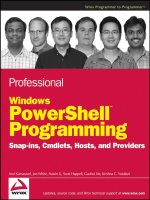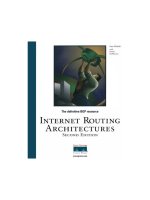Tài liệu SQL Clearly Explained- P1 ppt
Bạn đang xem bản rút gọn của tài liệu. Xem và tải ngay bản đầy đủ của tài liệu tại đây (1.12 MB, 50 trang )
Please purchase PDF Split-Merge on www.verypdf.com to remove this watermark.
SQL Clearly
Explained
Please purchase PDF Split-Merge on www.verypdf.com to remove this watermark.
SQL Clearly
Explained
Third Edition
Jan L. Harrington
Please purchase PDF Split-Merge on www.verypdf.com to remove this watermark.
Morgan Kaufmann Publishers is an imprint of Elsevier.
30 Corporate Drive, Suite 400, Burlington, MA 01803, USA
This book is printed on acid-free paper.
© 2010 E
LSEVIER
I
NC
. All rights reserved.
No part of this publication may be reproduced or transmitted in any form or by any means, electronic
or mechanical, including photocopying, recording, or any information storage and retrieval system,
without permission in writing from the publisher. Details on how to seek permission, further
information about the Publisher’s permissions policies and our arrangements with organizations such
as the Copyright Clearance Center and the Copyright Licensing Agency, can be found at our
website: www.elsevier.com/permissions.
This book and the individual contributions contained in it are protected under copyright by the
Publisher (other than as may be noted herein).
Notices
Knowledge and best practice in this field are constantly changing. As new research and experience
broaden our understanding, changes in research methods, professional practices, or medical
treatment may become necessary.
Practitioners and researchers must always rely on their own experience and knowledge in evaluating
and using any information, methods, compounds, or experiments described herein. In using such
information or methods they should be mindful of their own safety and the safety of others, including
parties for whom they have a professional responsibility.
To the fullest extent of the law, neither the Publisher nor the authors, contributors, or editors, assume
any liability for any injury and/or damage to persons or property as a matter of products liability,
negligence or otherwise, or from any use or operation of any methods, products, instructions, or
ideas contained in the material herein.
Library of Congress Cataloging-in-Publication Data
Harrington, Jan L.
SQL clearly explained / Jan L. Harrington. -- 3rd ed.
p. cm.
Includes indexes.
ISBN 978-0-12-375697-8
1. SQL (Computer program language) I. Title.
QA76.73.S67H37 2010
005.13'3--dc22 2010009181
British Library Cataloguing-in-Publication Data
A catalogue record for this book is available from the British Library.
For information on all Morgan Kaufmann publications,
visit our Web site at www mkp.com or
www.elsevierdirect.com
Printed in the United States of America
10 11 12 13 14 5 4 3 2 1
Please purchase PDF Split-Merge on www.verypdf.com to remove this watermark.
xiii
Preface to the Third
Edition
If you have had any contact with a relational database, then it
is very likely that you have seen the letters “SQL.” SQL (Struc-
tured Query Language) is a computer language designed to
manipulate relational databases. You can use it to dene a da-
tabase’s structure, to modify data, and to retrieve data.
is book has been written to give you an in-depth introduc-
tion to using SQL, providing a gentle but complete approach
to learning the language. You will learn not only SQL syntax,
but also how SQL works. Understanding the “how” as well as
the “what” will help you create SQL statements that execute as
quickly as possible.
e elements of the SQL language covered in the rst four
parts of this book are based on those parts of the SQL standard
that are for use with pure relational databases. Part V covers
two non-relational extensions (XML and object-relational ca-
pabilities) that have been part of SQL since 2003. Virtually all
database management systems that support SQL will provide
the bulk of what you will nd in Parts I–IV; implementations
of the features in Part V are less common and tend to vary
from the standard.
ere have been some substantial enhancements to the SQL
standard since the second edition of this book, both in the
Please purchase PDF Split-Merge on www.verypdf.com to remove this watermark.
xiv Preface
relational core features and the non-relational features. ese
features have been integrated throughout this third edition.
Organization of This Book
e ve parts of this book take you from theory to practice:
◊ Part I: e theoretical material underlying relational
databases and SQL has been moved into two chapters
at the beginning of the book. In previous editions, the
material in Chapter 2 (relational algebra) was scattered
throughout the book. is organization should make it
easier to nd. e third chapter in Part I provides an
overview of SQL environments.
◊ Part II: Part II covers interactive SQL retrieval. At rst,
this might seem backwards. Why discuss retrieving data
before creating a database and getting data into that da-
tabase? ere is actually a very good reason for this.
SQL presents someone trying to learn the language with
a bit of a catch-22. You need to know how to retrieve
data before you can modify it, because modifying data
means nding the data you want to change. On the
other hand, you need to be able to create a database and
enter some data before you have some data on which
you can perform retrievals. Like Yossarian trying to meet
with Major Major, it doesn’t seem that you can win!
e best alternative is to have someone who knows how
to do it create a sample database and load it with data
for you. en you can learn to query that database and
carry those techniques over to modifying data. At that
point, you’ll have an understanding of SQL basics and
will be ready to learn to create databases.
Please purchase PDF Split-Merge on www.verypdf.com to remove this watermark.
Preface xv
◊ Part III: Part III discusses creating and managing data-
base structure. It also covers non-data elements in the
database environment, such as managing users/ user ac-
counts and transaction control.
◊ Part IV: When SQL-based database environments are
being developed, programmers and database adminis-
trators do a lot of work using a command-line interface.
ere are, however, at least two reasons why SQL pro-
gramming is very common:
o e typical end-user should not (or cannot) work
directly from the SQL command line. We there-
fore create application programs to isolate them
from direct interaction with the SQL command
processor by writing application programs for
them to use.
o In many cases, there are actions the database should
perform in specic circumstances. We don’t want
to require users to remember to do these actions,
so we write blocks of program code that are stored
within the database to be executed automatically at
the appropriate time.
Part IV introduces several techniques for SQL program-
ming: embedded SQL (using a high-level host lan-
guage), dynamic SQL, and triggers/stored procedures.
ese chapters teach you syntax of SQL programming
constructs, but do not teach programming.
◊ Part V: Part V discusses the non-relational extensions
that have been added to the SQL standard: XML and
object-relational capabilities. Just as Chapter 1 pres-
ents a brief introduction to the relational data model,
Chapter 18 covers object-oriented concepts, including
the dierences between pure object-oriented databases
Please purchase PDF Split-Merge on www.verypdf.com to remove this watermark.
xvi Preface
and object-relational databases. Chapter 19 then looks
at SQL’s object-relational features.
Database Software
Much of today’s commercial database software is very ex-
pensive and requires expensive hardware on which to run. If
you are looking for a database management system for your
own use, you needn’t purchase anything should you choose
not to. ere are at least two open-source products that will
run on reasonable hardware congurations: mySQL (http://
www. mysql.com) and PostgreSQL (tgresql.
org). Both are certainly used in commercial settings, but can
also function well as learning environments. Distributions are
available for Windows, Linux, and Mac OS X.
e SQL commands to create the sample database used in the
rst four parts of this book and the SQL commands to insert
data into those tables can be downloaded from the Morgan
Kaufmann Web site.
Teaching Materials
If you are using this book as a college text (perhaps jointly with
its companion volume, Relational Database Design and Imple-
mentation Clearly Explained), you can nd teaching support
materials on the Morgan Kaufmann Web site. ese include
a sample syllabus, assignments (and where appropriate, solu-
tions), a project description, and exams.
Acknowledgements
Although an author spends a lot of time alone in front of the
computer, no book can come into being without the coopera-
tion and hard work of many people. It may be my name on
Please purchase PDF Split-Merge on www.verypdf.com to remove this watermark.
Preface xvii
the cover, but without the people at Morgan Kaufmann, you
wouldn’t be holding this book right now.
First I’d like to thank the editorial sta, Rick Adams (Senior
Acquisitions Editor) and Heather Scherer (Assistant Editor).
You’re a joy to work with (as always). Second, I am forever
grateful for the production sta, who have done everything
they can to make my life easier and to produce a great volume:
Anne McGee (Project Manager), Joanne Blank (Designer),
and Carol Lewis (Copyeditor).
I also can’t forget my support sta: my mother, my son, and
the four fur kids. (Now, if the kittens could just distinguish
between my leg and a scratching post, my world would be at
peace.)
Please purchase PDF Split-Merge on www.verypdf.com to remove this watermark.
1
3
You don’t need to be a database designer to use SQL success-
fully. However, you do need to know a bit about how rela-
tional databases are structured and how to manipulate those
structures. is chapter therefore will acquaint you with the
basic elements of the relational data model and its terminolo-
gy. We’ll nish by looking at the design of the sample database
used throughout this book.
1
A database is a place where we store data, but there is more to
it than that: We also store information about the relationships
between pieces of data. e organization of a database is a logi-
cal concept rather than a physical one. Yes, there are les that
store the data in a database, but the physical structure of those
les usually isn’t a concern for those who use the data.
e software that organizes, stores, retrieves, and analyzes data-
base data is known as a database management system (DBMS).
It isolates the user from the physical data storage mechanisms
and structures and lets the user work with data in terms of the
logical structure of the data.
1
If you have been reading this book’s companion volume, Relational
Database Design and Implementation Clearly Explained, then you will be
familiar with the concepts presented in this chapter. You can therefore
skip to the last section of this chapter to review the design of the sample
database.
Schemas and
Entities
The Relational Data
Model
©2010 Elsevier Inc. All rights reserved.
10.1016/B978-0-12-375697-8.50001-7
Please purchase PDF Split-Merge on www.verypdf.com to remove this watermark.
4 Chapter 1: The Relational Data Model
e overall logical plan of a database is known as a schema. A
schema has two types of elements:
◊ Entities: An entity is something about which we store
data, such as a customer or a product or an order for a
product. Entities are described by pieces of data known
as attributes. When we have a collection of data for all the
attributes of an entity, we say we have an occurrence of the
entity. Databases actually store occurrences of entities.
Schemas show us what entities will be in the database and
what attributes are used to represent those entities.
◊ Relationships: Relationships dene how entities interact.
For example, a customer entity is typically related to many
Relational Data Model Origins
e theory of the relational data model was developed by Edgar
(E. F.) Codd and introduced to the world in a paper published in
1970.
1
Codd continued to rene the model throughout his life,
in 1985 publishing 12 rules to which relational DBMSs should
adhere.
2
At that time, no DBMS met the rules and some commer-
cially successful products met none of them. Eventually, Codd
wrote a book that contained 330 rules.
3
He felt that DBMSs had
met most of the original 12 rules and he wanted to give develop-
ers something to strive for.
1
Codd, E.F. (1970). “A Relational MOdel for Large Shared Data Banks”,
Communications of the ACM, 13 (6): pp. 377–387.
2
Codd, E.F. (1985). “Is Your DBMS Really Relational?”, ComputerWorld,
14 October, and “Does Your DBMS Run By the Rules?” ComputerWorld, 21
October.
3
Codd, E.F. (1990). e Relational Model for Database Management, 2
nd
ed.
Addison Wesley.
Please purchase PDF Split-Merge on www.verypdf.com to remove this watermark.
Relations and Tables 5
order entities. ere are three types of relationships, all
of which we will discuss shortly.
e most important thing to keep in mind is that a schema
shows the logical plan for a database, what entities and rela-
tionships could possibly be stored. However, inside the real-
world database, we have many occurrences of many entities,
each represented by descriptive data. We may not have occur-
rences of every entity in the schema or we may have thousands
(even hundreds of thousands) of occurrences of entities.
A relational database takes its name from the structure used
to represent an entity: a two-dimensional table with special
characteristics taken from mathematical set theory, where such
a structure is known as a relation.
2
To begin, let’s look at the
simple relation in Figure 1-1. At rst glance, the relation looks
like any table, but unlike other tables you may have encoun-
tered (for example, rectangular areas of spreadsheets), it has
some very specic characteristics.
Cust. #
First name
Last name Phone
0001 Jane Doe (555) 555-1111
0002 John Doe (555) 555-2222
0003 Jane Smith (555) 555-3333
0004 John Smith (555) 555-4444
Figure 1-1: A simple customer relation
A relation is a two-dimensional table with no repeating groups.
at means that if you look at the intersection of a column
and a row, there will be only one value. What you see in Figure
2
Don’t let anyone try to convince you that a relational database is called
so because there are “relationships between les.” at is just plain wrong.
Relations and
Tables
Columns and Rows
Please purchase PDF Split-Merge on www.verypdf.com to remove this watermark.
6 The Relational Data Model
1-2 is certainly a table, but it isn’t a relation. Why? Because
there are multiple values in some of the rows in the Children
column. In contrast, Figure 1-1 is a legal relation.
Note: Although the ocial name of the two-dimensional “thing”
we have been discussing is “relation,” most people consider the
word “table” to be synonymous and we will use both terms inter-
changeably throughout this book.
A relation has a name that is unique within its schema. Each
column (or attribute) in a relation also has a name, but in this
case, the name needs to be unique only within the table. In
fact, as you will see shortly, there are times when you actually
want to have columns with the same names in multiple tables.
In a well-designed relational database, each table represents an
entity. We often document entities (and, as you will see, the
relationships among them) in a diagram known as an entity-
relationship diagram (ERD). ere are many ways to draw
ERDs, each of which can convey just about the same informa-
tion. e particular style we’ll be using in this book is known
as the information engineering (IE) style. An entity is repre-
sented as a rectangle with its name in the top section and its
attributes in the bottom, as you see in Figure 1-3.
A relation is both column-order independent and row-order
independent. is mean that we can view the columns in any
order and the rows in any order without losing the meaning of
Cust. # First name Last name Phone Children
0001 Jane Doe (555) 555-1111 James, Mary, John
0002 John Doe (555) 555-2222 Peter
0003 Jane Smith (555) 555-3333 Liam, Sean, Collin
0004 John Smith (555) 555-4444 Amy, Anabel
Figure 1-2: A table that isn’t a relation
Chapter 1:
Please purchase PDF Split-Merge on www.verypdf.com to remove this watermark.
Relations and Tables 7
the data. e assumption is, however, that all the data in one
row remain in that row.
Each column in a relation has a domain, an expression of the
legal values for that column. In some cases, a domain is very
specic. For example, if you are working with a column that
stores the sizes of T-shirts, the entire domain might consist of
the values S, M, L, XL, and XXL. Domains are more com-
monly, however, general data types, such as integer or date.
3
Once you assign a domain to a column, the DBMS will en-
force that domain, rejecting any command that attempts to
enter a value into the column that isn’t from the domain. is
is an example of a constraint on a relation, a rule to which the
relation must adhere.
Each row in a relation must have a unique value that identi-
es the row. is primary key is made up of the values in one
or more columns (the smallest number of columns needed to
enforce uniqueness). A table that stores information about an
order, for example, would probably use the order number as
its primary key.
People are particularly dicult to identify uniquely, so we often
assign each person in a table an arbitrary number. If you look
back at Figure 1-3, you will see that there is a customer_numb
attribute, representing a number that will be simply given to
each customer when a row for a new customer is entered into
the table. e IE diagramming method places an asterisk in
front of the column or columns that make up a primary key,
just as is done in Figure 1-3.
3
In fact, today’s major DBMSs do not provide direct support for true
relational domains. Nonetheless you will see that there are SQL constructs
that simulate domains.
Domains
Primary Keys
Please purchase PDF Split-Merge on www.verypdf.com to remove this watermark.
8 The Relational Data Model
Sometimes there is no single column that will uniquely iden-
tify each row in a table. As an example, consider the table in
Figure 1-4 (dependents), which lists employees’ dependent
children. We can’t use the employee number as the primary
key because customer numbers repeat for each child an em-
ployee has, and many employees have more than one child.
By the same token, the children’s names and birthdates aren’t
unique. e solution is to consider the values in two columns
as the primary key. In this case, the employee number and
the child’s name make the best primary key. Taken as a unit,
the two values are unique in every row. A primary key made
up of more than one column is known as a concatenated key.
Emp. #
Child name
Child birth date
0001 Sarah 1-15-2000
0002 John 2-12-1999
0002 Mary 6-6-2004
0002 John 4-15-2006
0003 Pamela 10-10-2004
0003 Paul 10-10-2004
Figure 1-4: A relation with a concatenated primary key
Figure 1-3:
A UML etity
Chapter 1:
Please purchase PDF Split-Merge on www.verypdf.com to remove this watermark.
Relations and Tables 9
Why are unique primary keys so important? Because they en-
sure that you can retrieve every piece of data that you put into
a database. If primary keys aren’t unique, a query will retrieve
one or more rows with a value you specify, but you can’t be cer-
tain which is the exact row you want unless you know some-
thing that identies just that one row. In fact, you should be
able to retrieve any single data value knowing three things: the
name of the table, the name of the column, and the primary
key of the row.
As you will see later in this book, you specify a table’s primary
key when you dene the table to the DBMS. e DBMS will
then enforce a constraint that requires unique primary key
values.
Note: It is actually possible to create a table that has no primary
key, but some DBMSs won’t let you put any data in it.
Sometimes you don’t put data in some columns of some rows
because you don’t know the appropriate data values. e empty
columns don’t contain a zero or a blank. Instead, they contain
a special indicator known as null, which means “unknown.”
ere are two important implications of the presence of nulls
in a table. First, we can’t allow nulls as all or part of a primary
key. If there is only one row with null for a primary key, then
the property of unique primary key values is preserved. e
minute we introduce a second row with a null primary key,
however, the primary keys are no longer unique. A DBMS will
therefore ensure that all primary keys have values, a constraint
known as entity integrity.
Secondly, nulls can aect the result of queries. Assume, for
example, that you want to retrieve the names of all employees
who have a salary of more than $100,000. For all employees
that have a value in the salary column, the answer to “Is the
salary more than $100,000” will be either “yes” or “no.” But if
Nulls
Please purchase PDF Split-Merge on www.verypdf.com to remove this watermark.
10 Chapter 1: The Relational Data Model
the salary column contains null, the DBMS doesn’t know the
answer to the question; the result is “maybe.”
We say that a DBMS operates using three-valued logic: yes,
no, or maybe. e question that remains is what a DBMS
should do when the answer to the question it is asking is “may-
be.” Should it retrieve rows with null or leave them out? e
relational data model doesn’t specify exactly what a DBMS
should do, but does require the DBMS to act consistently—
either always retrieve rows with nulls or always leave them
out—and that the user be aware of what is happening. We’ll
deal with eect of nulls at various places throughout this book.
ere are two primary types of tables with which you will be
working when you use SQL. e tables that contain data that
are stored in the database are known as base tables. However,
the DBMS also uses several types of temporary tables that only
exist in main memory. ese are virtual tables and by deni-
tion they are not stored in the database. Most modern DBMS
use several types of virtual tables, including views, temporary
tables, and query result tables. If you want to keep the data in a
virtual table, then those data must be inserted into a base table.
Along with data describing entities, a database must somehow
represent relationships between entities. Prior to the relational
data model, databases used data structures embedded in the
data to show relationships. However, the relational data model
relies on it data to show relationships.
ere are three types of relationships between entities that we
encounter in our database environments: one-to-one, one-to-
many, and many-to-many.
A one-to-one relationship exists between two entities when an
occurrence of entity A is related to zero or one occurrences of
entity B and an occurrence of entity B is related to zero or one
occurrences of entity A. Although the specic occurrences in-
volved in the relationship may change over time, there is never
Base versus Virtual
Tables
Representing
Relationships
Types of
Relationships
One-to-One Relationships
Please purchase PDF Split-Merge on www.verypdf.com to remove this watermark.
Representing Relationships 11
more than one related occurrence at any given time. For ex-
ample, a car and its engine have unique serial numbers. At any
one time, an engine is installed in only one car; at the same
time, a car has only one engine. e engine may be in no car
or it can be moved from one car to another, but it can’t be in
more than one place at a time. By the same token, a car can
have no engine or one engine. e specic engine may change
over time but there is never more than one.
4
We include a relationship in an ERD by drawing a line be-
tween the rectangles for two related entities. e line ends
identify the type of the relationship. In Figure 1-5 you can see
the way in which we would diagram the one-to-one relation-
ship between a car and its engine. e |0 at the end of the line
means “zero or one.”
If the relationship is required (mandatory), then the |0 at the
end of the line changes to || (one and only one). We use man-
datory relationships when we don’t want an occurrence of an
entity to be store in the database unless it is related to an oc-
currence of the entity at the other end of the relationship. For
example, if we didn’t want an engine in the database unless
that engine was in a car, the end of the line next to the car
entity would be ||.
True one-to-one relationships are very uncommon, but da-
tabase environments are full of one-to-many relationships.
When a one-to-many relationship exists between two entities,
one occurrence of entity A is related to zero, one, or more oc-
currences of entity B; each occurrence of entity B is related to
at most one occurrence of entity A. If, for example, we add car
owners to our car database, then there will be a one-to-many
4
Yes, there is at least one exception to the statement that a car has only
one engine: hybrids have a gasoline engine and an electric engine. ere
are exceptions to just about every scenario in this book, so please take
them in the spirit in which they were intended: as examples.
One-to-many Relationships
Please purchase PDF Split-Merge on www.verypdf.com to remove this watermark.
12 The Relational Data Model
relationship between an owner and a car. At any time, a person
can own zero, one, or more cars and a car belongs to zero or
one owners.
Figure 1-5: A one-to-one relationship
In an ERD, the line between the related entities has |0 or ||
at one end, representing the zero, one, or more end of the
relationship (or one and only one in the case of a mandatory
relatioship). e end of the line at the “many” side of the re-
lationship is marked with >0 or >|, representing zero, one, or
more (or in the case of a mandatory relationship, one or more).
In Figure 1-6, the owner entity is at the “one” end of the rela-
tionship and the car entity is at the “many” end.
Chapter 1:
Please purchase PDF Split-Merge on www.verypdf.com to remove this watermark.
Representing Relationships 13
Figure 1-6: Adding a one-to-many relationship
e third type of relationship between entities, a many-to-
many relationship, is also very common. When two entities are
related in that way, one occurrence of entity A can be related
to many occurrences of entity B (zero, one, or more) and one
occurrence of entity B can be related to many occurrences of
entity A. To demonstrate, let’s add an entity for a Web site to
the car database, indicating which cars are advertised on which
Web sites. A car can be advertised on many Web sites and a site
can advertise many cars.
e many-to-many relationship has been diagrammed in Fig-
ure 1-7. Notice that each end of the line connecting the Web
site and Car entities has the “many” symbol, >0.
Many-to-many
Relationships
Please purchase PDF Split-Merge on www.verypdf.com to remove this watermark.









